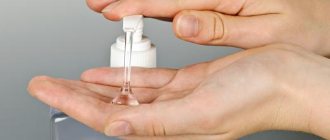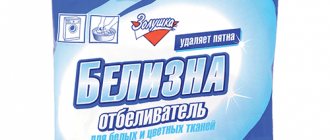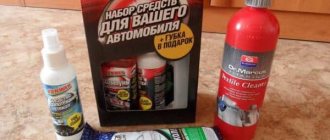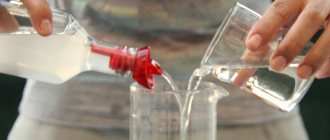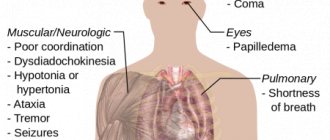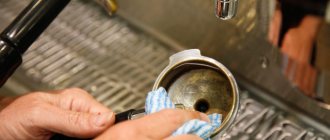Dry bleach (“bleach”) is a disinfectant that has proven its effectiveness over decades of use and has no more effective analogues. It consists of calcium hydroxide (slaked lime), hypochlorites, chlorides, chlorates and calcium carbonates, containing 20-25% of the active substance. Available in the form of a white or lightly colored powdery mass.
The popularity of this material is largely due to the fact that only chlorine is capable of destroying some viruses and bacteria: the causative agents of HIV infection, hepatitis, tuberculosis and other dangerous diseases.
Chloride of lime for disinfection is used both in dry and diluted with water form. It should be borne in mind that chlorine is active only in a humid environment, so bleach (powder) must be used on pre-moistened surfaces. For maximum effect, a mixture called “master batch” is prepared, as well as its varieties.
Chlorine-containing disinfectants
For disinfection, use bleach (bleach) or products containing 1–30% active chlorine. They smell unpleasant, but quickly destroy the membranes of bacteria, yeast, mold, spores, and all types of viruses.
For disinfection, chlorine is produced:
- tablets - “Aquatabs” (3600 rubles for 60 pcs.), “Oka-Tab” (500 rubles for 300 pcs.) and others;
- granules - “Glavchlor” (700 rubles per 1 kg), “Septochloral” (750 rubles per 1 kg), others;
- powders - “Lumax” (600 rubles per 1 kg), “Tepsichlor” (1000 rubles per 2 kg), “Chloramine” (150 rubles per 300 g), others;
- solutions - “Belizna” (50 rubles per 1 l), “Hypostabil” (600 rubles per 5 l), “Domestos” (100 rubles per 1 l), others;
- gels - Sanfor Universal (100 rubles per 1 l), “Whiteness” (100 rubles per 1 l), others.
Bleach powder for disinfection consists of chloride, hypochlorite, calcium hydroxide. The formula is written as 3Ca(OH)2 × 2Cl2.
The product is caustic, class 2 danger to life and health, damages materials. In housing it is better to use liquid solutions with sodium hypochlorites.
Hypochlorites (HClO) are salts of hypochlorous acid (a substance that oxidizes chlorine). There is sodium hypochlorite (NaOCl) and calcium hypochlorite (Ca(ClO)2).
Where to buy disinfectants
Bleach and products based on it are sold in household chemicals sections and hardware stores. Online stores also offer a large selection of disinfection products.
Chemical properties
Hypochlorites are unstable compounds that easily decompose with the release of oxygen. The decomposition of solid sodium and calcium hypochlorites can be represented by the equations
2NaClO = 2NaCl + O 2 ↑ and 2Ca(ClO) 2 = CaCl 2 + O 2 ↑.
Processes at room temperature occur slowly, and when heated they can occur explosively. In parallel with reactions accompanied by the formation of chlorides and free oxygen, disproportionation reactions can occur
The decomposition of hypochlorites in aqueous solutions depends on the acidity of the solution and its temperature. In strongly acidic environments at pH ≤ 3, hypochlorous acid decomposes to chlorine and oxygen at room temperature
4HClO = 2Cl 2 ↑ + O 2 ↑ + 2H 2 O.
If hydrochloric acid is used during acidification or chlorides are present in the solution, oxygen does not form
HClO + HCl = Cl 2 ↑ + H 2 O.
Hypochlorous acid is very weak, so it can be displaced from a solution of its salts by the action of carbon dioxide
ClO – + CO 2 + H 2 O = HCO 3 – + HClO.
In slightly acidic and neutral environments at 3 2 ↑.
In neutral and alkaline solutions, a competing reaction of the formation of chlorides and chlorates takes place
At room temperature, the disproportionation reaction proceeds slowly, but at temperatures above 70°C this reaction becomes predominant.
In alkaline environments at pH > 7.5, hypochlorite ions predominate in solutions, decomposing as follows:
About 95% of the total amount of hypochlorite ions decomposes as a result of successive reactions (1) and (2), with reaction (1) being the slowest (limiting) and determining the overall rate of the process. Reaction (3) is not the main one, but is responsible for the release of oxygen, the amount of which can be significant.
In the presence of some metal ions, for example, copper, nickel, cobalt, catalytic decomposition of hypochlorite ions is observed. Iron ions have a weak catalytic effect and are cocatalysts in combination with other metal ions. In the simplest case, when the solution contains copper(II) ions at a concentration of 1 mg/kg, the orders of homogeneous reaction for hypochlorite and copper(II) are equal to unity.
Heterogeneous catalysis by metals and their insoluble compounds is complex and poorly reproducible. Of the insoluble catalysts, the greatest interfering effect is exerted by nickel and its oxides, which enter hypochlorite solutions upon contact with alloyed nickel steels used for the manufacture of pipelines and tanks.
The rate constants of reactions (1)-(3) are greatly influenced by the ionic strength of solutions. High electrolyte concentrations reduce reaction rate constants and provide reasonable storage stability for electrolyte solutions. An increase in the concentration of hypochlorite ions, on the contrary, reduces their stability in aqueous solutions. In Fig. Figure 2 shows the phenomenon of the “intersection curve”. Solutions of sodium hypochlorite with a concentration of 9% and 5% decompose during storage so much that after 50 weeks they show the same concentration of the substance, and after 100 weeks the initially more concentrated solution contains less hypochlorite ions than the diluted one.
Rice. 2. Decomposition of sodium hypochlorite of various concentrations at 30°C.
An increase in temperature accelerates the decomposition processes of hypochlorites, so it is advisable to store hypochlorite solutions in a cool place to ensure shelf life (Fig. 3).
Rice. 3. The effect of temperature on the decomposition of a 5% NaClO solution.
To stabilize aqueous solutions of hypochlorites, as well as products based on them, each manufacturer uses its own methods, which are rarely published in the form of articles. However, some patented methods are known, which, without pretending to be complete, can be presented in the following list:
The direction of redox processes involving hypochlorite ions and hypochlorous acid is determined by the values of standard electrode potentials of half-reactions in an aqueous environment:
2HClO + 2H + + 2e – = Cl 2 ↑ + 2H 2 O, E° = 1.630 V,
HClO + H + + 2e – = Cl – + H 2 O, E° = 1.500 V.
in neutral and alkaline environment
Thus, hypochlorite ions and hypochlorous acid have pronounced oxidizing properties, and their oxidizing ability in an acidic environment is much higher than in neutral and alkaline environments.
Does bleach kill coronavirus?
COVID-19, according to WHO, is destroyed by products containing more than 60% chlorine or alcohol. Bleach or solutions containing it are suitable for disinfection against coronavirus, influenza, ARVI, enteral hepatitis, and other viruses. It also kills Candida fungi, tuberculosis bacillus, and 90% of known bacteria.
Treatment with liquid bleach against coronavirus is recommended. Use a powder solution of 10–20 g per 1000 ml of water. Granules and tablets are diluted according to the instructions on the package, since they come in different concentrations.
A mixture of 1% Chlorhexidine, 0.01% sodium hypochlorite and 70% alcohol is effective. Within 2 minutes of treatment, the coronavirus shell is damaged and the pathogen loses its ability to reproduce.
History of discovery
In 1774, Swedish chemist Carl Wilhelm Scheele obtained chlorine (Cl 2 ) as a result of the reaction of manganese(IV) oxide MnO 2 and hydrochloric acid (HCl). Later, in 1785, French chemist Claude Louis Berthollet discovered that an aqueous solution of chlorine gas (“chlorine water”) containing hypochlorous and hydrochloric acids could bleach laundry, and reported his findings to the French Academy of Sciences.
Cl 2 + H 2 O = HClO + HCl
Knowledge of the bleaching properties of chlorine was immediately put to use by James Watt in a textile factory in Glasgow. Despite the fact that bleaching using chlorine was significantly more effective than traditional methods of bleaching with sunlight, weak solutions of acids and alkalis, the use of chlorine was limited by its toxicity and destructive effect on fabrics. To stabilize the solution of chlorine gas in water and the safety of its use, in 1787, at the Parisian enterprise Societe Javel, chlorine began to be passed through an aqueous solution of potassium carbonate (potash)
Cl 2 + K 2 CO 3 = 2KHCO 3 + KClO + KCl.
The head of the company, Leonard Alban, called the new product “Eau de Javel” (“javel water”), and soon the bleaching liquid became popular in France and England.
In 1820, the Frenchman Antoine Labarrac improved the method of producing bleach by replacing potash with cheaper sodium hydroxide (caustic soda). The resulting solution of hypochlorite and sodium chloride was called “Eau de Labarraque” (“Labarraque water”).
Cl 2 + 2NaOH = NaClO + NaCl + H 2 O.
The widespread use of hypochlorites for disinfection of drinking water and disinfection became possible much later, at the beginning of the 20th century, thanks to the development of industrial production of chlorine by electrolysis of table salt.
Areas of application of bleach
Bleach disinfects sources of pathogens and surfaces on which they can settle. Indoors it is used to disinfect homes and entrances, medical institutions, and public institutions.
Where else is disinfection carried out with bleach:
- chlorination of water and equipment in the pool;
- disinfection of public toilets;
- disinfection of animal cages/premises;
- treatment of the greenhouse in the spring (against mold);
- disinfection of drains, sedimentation basins, burial grounds.
In everyday life, bleach or “Whiteness” is also used to wash, bleach fabrics, remove stains, and eliminate the smell of animal urine. They can be used to disinfect dishes from which a patient with an infection has eaten.
See how the product is used:
conclusions
To disinfect a room where animals grow and reproduce, it is recommended to treat it with aerosols obtained by actively combining bleaching lime with formaldehyde or ammonium nitrate. This composition can also be used to treat hatching eggs.
A combination of methanal (thirty-eight percent solution) and lime (twenty-eight percent chlorine) is acceptable. Methanal and a technical mixture of hypochlorite, chloride and calcium hydroxide are diluted in special twenty-liter vessels.
After disinfection, the number of bacteria decreases significantly within a week. For preventive purposes, disinfection can be carried out at weekly intervals. Veterinarians recommend disinfection with aerosols when respiratory illnesses occur.
How to dilute bleach for disinfection
It is recommended to prepare solutions outdoors or in a ventilated room. They work in personal protective equipment. The concentration is selected taking into account the manufacturer’s recommendations and sanitary and hygienic standards.
Mother liquor and its varieties
Make a 10% (clarified stock) bleach solution from 1 kg of dry bleach and 10 liters of cold water (1:10).
- A single dose of powder or granules is poured into an enamel container, moistened and ground to a creamy consistency.
- Then it must be diluted with the remaining water, stirred, covered with a lid and left for a day (shaken carefully for the first 4 hours).
- Remove the foam, drain the liquid without sediment into a glass container, and store for a week.
Disinfectants are prepared from the mother liquor and water (see table).
Percentage ratio of working solutions for disinfection:
| Concentration of active chlorine in the finished liquid | Proportion | |
| Stock solution (ml) | Water (l) | |
| 5% (for plumbing equipment) | 5000 | 5 |
| 1% (for surfaces in toilets) | 1000 | 9 |
| 0.5% (for floors in housing) | 500 | 9,5 |
| 0.3% (d/bleaching) | 300 | 9,7 |
| 0,2 % | 200 | 9,8 |
| 0,1 % | 100 | 9,9 |
There is also an unclarified bleach stock solution or “milk”.
It is done according to the scheme:
- Dissolving 1–2.5 kg of dry bleach until sour cream.
- Add water to a volume of 10 liters.
- Stir until completely dissolved.
“Milk” is not stored, it is used immediately.
How to dilute a bleach tablet for disinfection
The product is produced with different weights and active chlorine content. There is a different consumption of tablets for disinfecting water in the pool, open sources, household and hospital surfaces. The dose is determined according to the recommendations on the label and sanitary and hygienic standards.
How to properly dilute bleach tablets to disinfect pool water:
- The tablets are placed in an enamel container (usually at the rate of 200 g/per 20 m3).
- Fill with water at room temperature.
- Wait for complete dissolution.
- Pour the bleach solution into the pool.
To disinfect surfaces with bleach, make a working solution with a concentration of 0.015–0.3% from 1–20 tablets per 10 liters of water. They are completely dissolved in a container intended for cleaning. The liquid is used immediately.
How to dilute bleach
Chlorine-lime “milk” (whitewash) is suitable for disinfecting waste. Prepare 10% from 1 kg of dry bleach and 10 liters of cool water (1:10). If necessary, the dose of bleach powder is increased to 2 kg.
How to prepare “chlorine milk”:
- In an enamel bucket, grind all the powder with a small amount of water. The mixture should resemble sour cream.
- The gruel is diluted with the rest of the water, bringing the volume to 10 liters.
“Milk” is used immediately after dilution.
Bleach - obtaining
Chloride of lime is obtained as a result of the reaction of gaseous chlorine with dry calcium hydroxide, or as it is otherwise called - slaked lime Ca(OH)2. The resulting chlorine is diluted with air during the electrolysis of a NaCl solution. The gas supplied for chlorination most often contains 40-50% CI2. The permissible content of H2 and CO2 in the gas is less than 1.5% and 0.4%, respectively, based on 90-98% chlorine gas. The moisture volume should not exceed 0.06%. Slaked lime is made from powdered lime, which contains a lot of calcium. The full production cycle of bleach includes the following stages:
- limestone burning
- obtaining fluff (slaking lime)
- chlorination of fluff.
Lime is obtained by burning limestone or chalk under conditions of 950-1100° degrees. Limestone is a denser rock compared to chalk, which has significant porosity and a high level of humidity - 90%. For firing, limestone with pieces with sizes from 70 to 120 mm is taken. It must contain at least 91% CaCO3, as well as a maximum of 1.7% MgC03 and 0.2% R203. Approximately 1% impurities in limestone as a result of calcination will result in almost 2% impurities in burnt lime. Certain natural high-grade limestones contain: 97-95% CaC03 1 - 1.5% MgCO3 0.2-0.5% CaS04 0.2-0.5% insoluble substances 0.8-1% moisture 0.1 -0.2% FeSO3 0.2-0.4% AI203 0.3-0.5% Si02 0.2-0.4% other additives. During the burning of limestone, the dissociation reaction of calcium carbonate is observed:
- CaCO3 = CaO + CO2 - 42.5 kcal
The required amount of heat is achieved by burning coke or other types of fuel. In this case, the coke should contain no more than: 0.7% S, 12% moisture, 5% ash, and 1.7% volatile compounds. Solid fuel is used in pieces with dimensions of 40-60 mm. The process of limestone dissociation occurs with sufficient completeness already at 900°. However, to speed up firing, the temperature in the hottest zone should be between 1000-1100°. If the temperature is lower, then part of the limestone inside large pieces will not have time to decompose and the result will be “underburned” or “underburned,” which worsens the quality of the final product and increases the volume of waste during its extinguishing. At the same time, higher temperatures also do not benefit the process. It causes melting of pieces of lime as a result of the presence inside limestone and coal ash of silica impurities, oxides of iron, aluminum, magnesium and others, which form fusible silicates. Lime of this composition can be slowly extinguished with water, and part of it, together with the “under-burnt”, is screened out at the end of the extinguishing from the dispersed fluff in the form of large pieces of “overburn” or “overshoot” that did not have time to extinguish. The limestone firing process is carried out in shaft transfer kilns, as well as in kilns with remote fireboxes. The minimum amount of contamination of burnt lime with ash and unburned pieces of fuel is observed in kilns with remote fireboxes (gas kilns). Such devices have significant advantages over transfer furnaces due to the possibility of using more inexpensive types of fuel (compared to coke and anthracite). Next, chlorine interacts with slaked lime:
- 2CI2+2Ca(OH)2=Ca(OCI)2+CaCI2+2H20
In fact, we obtain a product that is a mixture of compounds consisting of molecules Ca(OCl)2, CaCl2, Ca(OH)2 and water of crystallization. If a fairly pure hydroxide was initially taken, and treatment with chlorine was carried out until complete saturation, then the composition of freshly prepared bleach will look like this:
- Ca(OCl)2•CaCl2•Ca(OH)2•2H2O.
Instructions for use of bleach (sodium hypochlorite)
Before disinfection with bleach, remove children and animals from the room and immediately open a window for ventilation. Always wear rubber gloves and long sleeves when working. Wear a respirator and safety glasses. After sanitization, wash your hands and wash your face.
Disinfection features:
- liquid products with bleach - surfaces are cleaned of contaminants (they reduce antimicrobial activity);
- tablets - make a solution with the concentration specified in the recommendations, initially clean the surface, disinfect;
- powder - the surface to be disinfected is first moistened with water, then sprinkled with dry bleach.
Disinfection occurs only when bleach comes into contact with water. Therefore, disinfection is done with solutions or powder on wet surfaces.
How to prepare disinfectant at home:
Which surfaces should be disinfected?
Use bleach to wipe all surfaces touched by hands. Handles of doors, windows, cabinets, taps, switches, remote controls and other household items, tables are disinfected. Toilets, sinks and bathtubs, floors, and panels are also disinfected.
Bleach damages plastic, metal, wood, textiles, and rubber. Antimicrobial activity is reduced if contaminated items are disinfected.
How many times a day is it safe to disinfect with bleach?
Bathrooms are treated with bleach solutions every 12 hours. Surfaces in living rooms are disinfected once a day. If there is a need to disinfect more often, re-sanitation is done with products containing soda and peroxide.
Cautions and usage details
In order to avoid negative consequences, when coming into contact with bleach, you should follow a number of rules . Here are the main ones:
- Persons under 18 years of age, as well as pregnant women, are prohibited from working with the drug.
- Before starting treatment, it is advisable to remove people and animals from the premises.
- It is necessary to protect the skin and mucous surfaces from the action of bleach. For this purpose, hands are covered with rubber gloves, respiratory organs are covered with a bandage, and eyes are covered with protective goggles. It is recommended to use a rubberized apron.
- After treatment, high-quality ventilation of the room is required.
- The storage conditions of both starting substances and finished solutions must not be violated.
- If the product gets on open areas of the body or mucous membranes, the affected area should be thoroughly rinsed with water. If accidentally swallowed, induce vomiting.
- If signs of chlorine vapor poisoning appear, you should immediately remove the victim to air and call an ambulance. Alarming symptoms: dizziness, nausea, taste of chlorine even in the absence of fumes, shortness of breath, soreness, lacrimation, pain in the peritoneum, vomiting.
Safety Notes
A weak solution of bleach does not kill pathogens, and the correct concentration is dangerous for humans and pets. Children and animals suffer the most.
Bleach can:
- burn your lungs;
- provoke bronchospasm, laryngospasm (fraught with death from suffocation);
- cause poisoning of the body;
- dry/inflame the mucous membrane of the nose and larynx;
- corrode skin, mucous membranes;
- provoke nosebleeds;
- cause eye irritation.
Products containing bleach cannot be disinfected frequently. Their excessive use increases the concentration of chlorine ions in the air. After treatment, the substance remains on surfaces and slowly evaporates.
Toxicity of chlorine-containing drugs
In nature, bleach forms dioxins. The substance is harmful to plants. In living organisms upon contact it causes tissue necrosis, burns of mucous membranes and respiratory organs, and poisoning.
Active chlorine releases toxic substances and/or vapors when mixed:
- with acids, including vinegar;
- sewer cleaning products (cannot be used together or in parallel);
- ammonia (ammonia).
Chlorine has a cumulative effect. Once ingested, it is not excreted and remains inside (or in nature) for up to 80 years.
Storage and shelf life of chlorine solution
Bleach (liquid concentrate, gel, powder, disinfectant) is kept in a dark place inaccessible to children and pets. Do not place near heating equipment or food.
Bleach is stored for a year or until the expiration date indicated on the packaging of the product. The container of the solution and bulk disinfectants must be tightly closed without damage.
Poisoning
Bleach poisoning of any degree can be treated under medical supervision. If assistance is not provided, a person can die within half an hour to 7 days.
Sequence of actions in case of poisoning:
- Cover your mouth and nose with a cloth (put on a mask), take the victim outside or open the windows and door for ventilation.
- They call an ambulance.
- Remove the source of chlorine (if the victim remained in the room).
- Provide first aid.
Chlorine is neutralized with a solution of baking soda in a proportion of 1 tsp. for 250 ml of water.
The person's clothes are unbuttoned (for women, the bra is also unfastened). If you faint, apply cotton wool with ammonia to your nose. If breathing stops, perform artificial mouth-to-mouth ventilation.
It is also advisable in case of bleach poisoning to:
- inhale with baking soda;
- rinse your nose, mouth, eyes generously;
- drink water, mineral water or milk.
If chlorine gets into the stomach, give up to 1 liter of water to drink and induce vomiting. Next, drink alkaline mineral water, milk or drinking water.
If chlorine gets on the skin, wash it with water or an alkaline solution. If there are symptoms of a burn, treat with Panthenol or apply grated potatoes. Deep injuries are treated with medications prescribed by a doctor.
If chlorine gets into your eyes, wash them generously with water or saline. Next, Novocain or Albucid is instilled and examined by an ophthalmologist.
Watch a video about what to do in case of poisoning:
Chlorine
Let's start with chlorine. I think there won’t be any special problems understanding him.
This is a yellowish-green gas with a pungent odor, poisonous, two and a half times heavier than air, and belongs to the second hazard class.
In its action it is classified as an asphyxiating gas and causes irritation of the mucous membranes. Upon penetration into the lower respiratory tract it causes pulmonary edema.
Starting his experiments with chlorine at the lecture, the German chemist Egon Wiberg addressed the students with the following words:
– Chlorine is known to be a poisonous gas. If I get poisoned during the next experiment and lose consciousness, please take me out into the fresh air. But, unfortunately, the lecture will have to be interrupted here.
It is not found in nature in free form, but in compounds - in abundance. The most commonly known to us is table salt (sodium chloride).
Chlorine became infamous after it was used in World War I as a poison gas.
Chlorine gas is widely used in industry:
- in non-ferrous metallurgy;
- in pulp and paper production;
- when chlorinating water;
- in the production of organochlorine compounds
- etc.
It is stored and transported in liquefied form in special containers - in cylinders, barrels, tanks, and already at the consumer’s place, liquid chlorine evaporates and enters technological processes in a gaseous state.
Right now, it is very important to improve the process of chlorine evaporation, that is, transferring it from a liquid to a gaseous state, because there are many difficulties and subtleties associated with this. Accordingly, equipment for this process (evaporators) is constantly being developed and improved. Well, of course, there is no escaping the safety rules when handling this clearly poisonous gas.
So, a short summary: chlorine is a gas with a pungent odor, poisonous, heavier than air, yellowish-green in color. If you delve a little deeper into chemistry, its molecule consists of two chlorine atoms connected to each other. There is nothing else in this molecule, only two chlorine atoms (chemists call such substances, consisting only of atoms of one chemical element, simple).
Analysis methods
Qualitative reactions to hypochlorite ion can be:
The most common method for quantitative analysis of hypochlorite ion is the titrimetric method using potassium iodide. To carry out the test, an aqueous solution or aqueous suspension containing hypochlorite ion is mixed with an excess solution of potassium iodide in a sulfuric acid medium. Keep the hermetically sealed mixture for 5 minutes in a dark place. The released iodine is titrated with a standardized solution of sodium thiosulfate. A starch solution is used as an indicator near the equivalence point.
When quantitatively determining the hypochlorite ion by the indirect iodometric method, the results of the analysis are converted into those released during the reaction
2H + + ClO – + Cl – = Cl 2 ↑ + H 2 O.
An alternative method for quantifying hypochlorite ion is potentiometric analysis using a bromine ion selective electrode. The concentration of the hypochlorite ion is found by adding the test solution to a standard solution or by reducing the concentration of the test solution by adding it to the standard solution.
Disinfectant effect
Hypochlorites are one of the best antibacterial agents. They kill microorganisms very quickly even at very low concentrations.
The highest bactericidal effect of hypochlorites is manifested in a neutral environment, when the concentrations of hypochlorous acid and hypochlorite ions are approximately equal (Fig. 1). The active particles formed during the decomposition of hypochlorites (atomic oxygen and chlorine) have a high biocidal effect. They destroy microorganisms by interacting with biopolymers in their structure that are capable of oxidation. In a similar way, for example, human cells act: neutrophils, hepatocytes, etc., which synthesize hypochlorous acid and accompanying highly active radicals to fight microorganisms and foreign substances.
The bactericidal activity of hypochlorites is so great that they can lead to the death of yeast-like fungi that cause candidiasis, Candida albicans, within 30 seconds when exposed to a 5.0 - 0.5% hypochlorite solution. Pathogenic Enterococcus faecalis dies 30 seconds after treatment with a 5.25% solution and 30 minutes after treatment with a 0.5% solution. Gram-negative anaerobic bacteria, such as Porphyromonas gingivalis, Porphyromonas endodontalis and Prevotella intermedia, die within 15 seconds after treatment with a 5.0 - 0.5% solution of hypochlorite ions.
Despite the high biocidal activity of hypochlorites, some potentially dangerous protozoan organisms, for example, the causative agents of giardiasis or cryptosporidiosis, are unfortunately resistant to its action.
With the help of hypochlorite ions, various toxins can be successfully neutralized (Table 3).
Table 3. Results of toxin inactivation during 30-minute exposure to various concentrations of sodium hypochlorite (“+” – the toxin is inactivated; “–” – the toxin remains active).
| Toxin | 2.5% NaClO + 0.25 N. NaOH | 2.5% NaClO | 1.0% NaClO | 0.1% NaClO |
| T-2 toxin | + | – | – | – |
| Brevetoxin | + | + | – | – |
| Microcystin | + | + | + | – |
| Tetrodotoxin | + | + | + | – |
| Saxitoxin | + | + | + | + |
| Palytoxin | + | + | + | + |
| Ricin | + | + | + | + |
| Botulinum toxin | + | + | + | + |
"Death Island"
Arkady Shaikhet/MAMM/MDF/
The sad story of one of the first batches of these forced special settlers, known as the Nazi tragedy, has become widely known.
More than six thousand people were disembarked in May 1933 from barges on a small deserted island on the Ob River near the village of Nazino in Siberia. It was supposed to become their temporary refuge while issues with their new permanent place of residence in special settlements were being resolved, since they were not ready to accept such a large number of repressed people.
People were dressed exactly the same as the police detained them in the streets of Moscow and Leningrad (St. Petersburg). They had neither bedding nor any tools to build a temporary home for themselves.
State Historical Museum of the Southern Urals/
On the second day the wind rose, and then frost struck, which soon gave way to rain. Defenseless against the vagaries of nature, the repressed could only sit in front of fires or wander around the island in search of bark and moss - no one took care of food for them. Only on the fourth day did they receive rye flour, which was distributed at a rate of several hundred grams per person. Having received these crumbs, people ran to the river, where they diluted flour in hats, footcloths, jackets and pants in order to quickly eat this kind of porridge.
The number of deaths among special settlers quickly grew into the hundreds. Hungry and cold, they either fell asleep right next to the fires and burned alive, or died from exhaustion. The number of victims also increased due to the cruelty of some guards, who beat people with rifle butts. It was impossible to escape from the “island of death” - it was surrounded by machine gun crews, who immediately shot those who tried.
Entry of hazardous substances through the stomach and skin
Exposure of the body to water with excess chlorine threatens disruption of the gastrointestinal tract and increases the risk of developing cholelithiasis and urolithiasis. Chlorine also destroys vitamin E, which is necessary for the normal functioning of the reproductive system. It penetrates into our body not only through drinking tap water, but also through the skin in the shower or swimming pool. Visitors to public swimming pools, where chlorine is used excessively to disinfect the water, may face the problem of developing dry eye syndrome, which leads to vision impairment. Moreover, frequent contact with chlorinated water negatively affects the condition of the skin, hair and even nails. Among the main signs of increased chlorine content in the body are:
a burning sensation in the eyes;
active lacrimation;
digestive disorders;
If you have pets at home
Those who live with cats and dogs know about specific problems that are becoming commonplace. These are not only urine stains, the smell from which is quite difficult to remove. Pets often get parasites, the larvae of which can wait on the floor for their time. Moreover, bleach for disinfecting premises can be used to destroy bacterial infections, including tuberculosis and viral infections, hepatitis, fungus, including candida, as well as all kinds of infections. Therefore, if you have pets, you should not forget about disinfection. But there is no need to use it constantly, especially since bleach is toxic. But periodically treating the room is not only possible, but also necessary.
Bleach is excellent at removing urine stains and odors, but for some animals, the smell of bleach itself is a stimulus to renew their “marks.” If your pet has this characteristic, then it is best to change the disinfectant.
